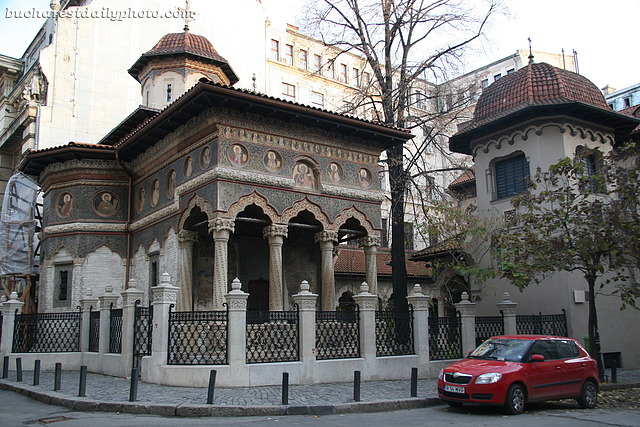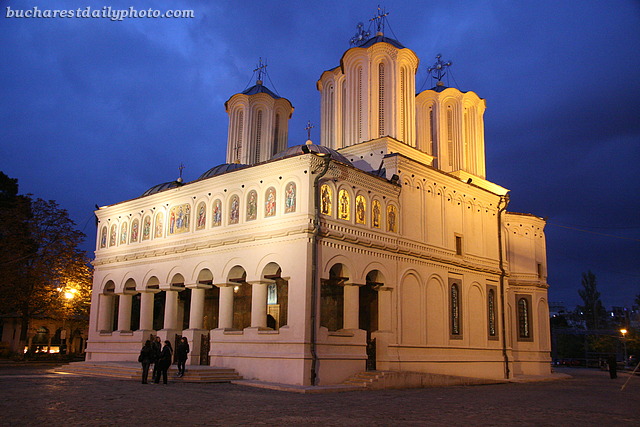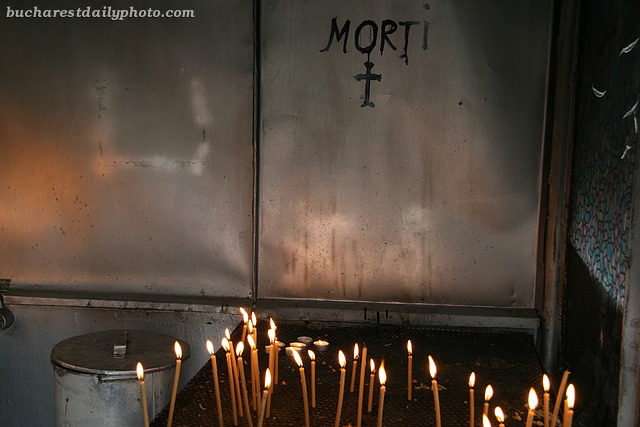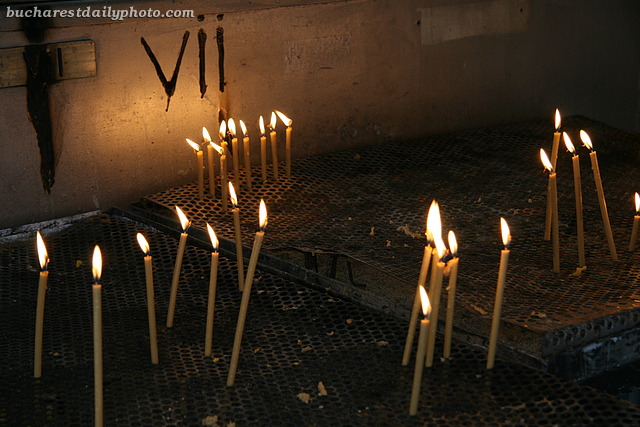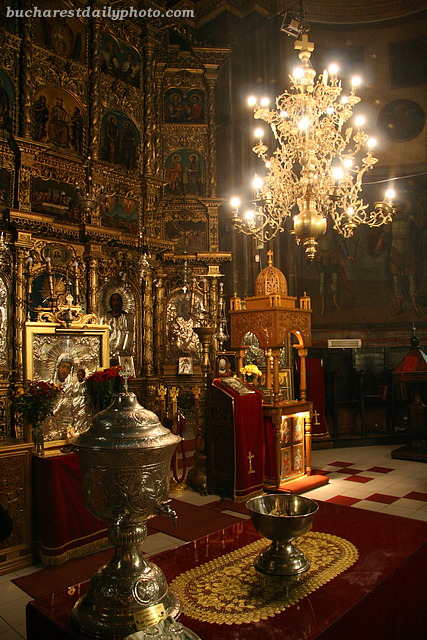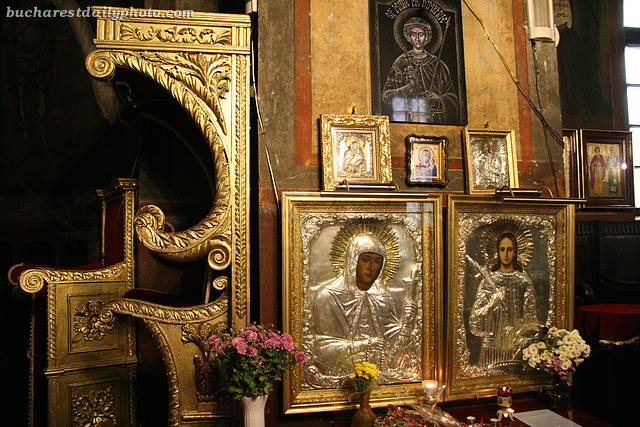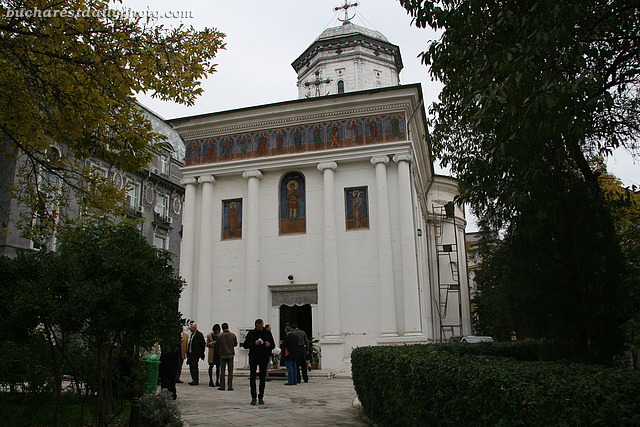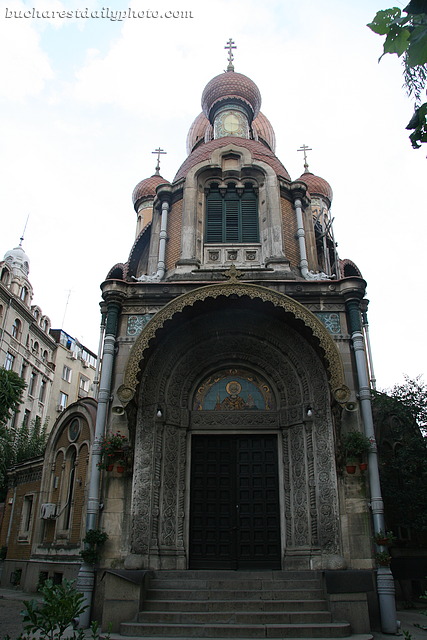This charming little church is one of the oldest in Bucharest. It was built between the years 1724 to 1730 during the ruling of Nicolae Mavrocordat (Prince of Wallachia 1719-1730) by the Greek monk Ioanichie Stratonikeas. Although tiny, every little detail is worth looking at: the richly adorned columns of the porch, the exterior paintings and carvings, the frescoes of the interior and the golden altar. I think it’s impossible to visit churches like Stavropoleos and not be moved in some way – I’m actually not sure that my photo does it justice, because it truly is one of a kind. In the past, the church was the centerpiece of a complex which included an inn and a monastery which was sustained from the incomes of the inn. They were demolished at the end of 19th century after being severely damaged during a fire, the church being the only part that remains from the original complex. Today the church is part of the Stavropoleos Monastery, an Eastern Orthodox convent. Stavropoleos is representative for the Brâncovenesc style which blends Ottoman and Western elements together with traditional Romanian architectural forms.
This elegant building is the center of the Romanian Orthodox Church which sits atop the Mitropoliei Hill. Bucharest has a string of small hills and in the past monasteries were built on top of these hills so they can be seen from afar. In the past the Patriarchal Cathedral was visible from most parts of the city but that has been rectified by the communists which fenced it with tall buildings. It’s a miracle that the building has not been demolished or moved somewhere else during the communist regime, as it happened with many other churches, but that may be due to the fact that the leaders of the Romanian Orthodox Church collaborated with the Communist Party in order to maintain what was left of their power. During the 15th century the Mitropoliei Hill was covered by vineyards and a small wooden church stood on top of it. Construction of the new church was started by Prince of Wallachia Constantin Şerban Basarab in 1656 and finished by Radu Leon in 1668 when it was named the official Metropolitan seat. None of the original interior paintings remain except for a single icon depicting the Saint Emperors Constantine and Helen which are the cathedral’s patron saints. The church was restored several times. The present day frescoes were painted by Dimitrie Belisarie in 1933. This is a place of gathering, and thousands of people take to the hill with the occasion of major religious holidays.
Today’s two photos are part of the St. Dumitru Chuch series. In the Eastern Orthodox church, candles are used in religious ceremonies or are lit by worshippers as offerings. In Bucharest churches the candle cabinets are usually placed outside the church, to protect it from fire and damage by smoke. The cabinets can be small or large, usually with doors to protect the candles from rain or from blowing out when it’s windy outside. As you can see in the photos, the cabinets are marked with “Dead” (“Morţi” in Romanian) or “Alive” (“Vii” in Romanian) as you can either light a remembrance candle for somebody who died or one to pray for help for the soul of someone who’s alive and going through harsh times.
I don’t like to take pictures inside churches because there’s always someone praying and I feel like intruding. But being at the church with the occasion of a baptizing I waited until everyone left and snapped a few quick shots. I don’t know if you had the occasion of visiting a Eastern Orthodox Church before, but what you see in today’s photographs is a pretty typical interior. Icons are not considered to be idols or objects of worship by the Eastern Orthodox, the thinking being that an icon is like a window and that is not the physical object that is venerated but rather the individual shown. Therefore orthodox churches have many icons adorning the walls, in fact many of them are completely covered in icons or frescoes. Also, as you can see in the second photograph, icons are often illuminated by a candle or oil lamp.
Last Sunday I was invited to a baptizing at this charming church that goes by the name of Saint Dumitru Church, also called “of Oath Taking” because in the 17th century the parts involved in a trial would come here and take an oath to tell the truth while wearing the Holy Belt of the Virgin Mary. It is also called “Saint Dumitru at the Post Office”, because of its location, and in the past it used to be called “Saint Dumitru of Badea Bălăceanu”, after the name of one of the first patrons of the church. Although it is located in Bucharest’s Old Town, this church is far less popular than its close neighbour Stavropoleous Church.
This peaceful looking church has quite a stormy history. You can skip this part if you’re not interested. I won’t tell 🙂 There was a wooden church on these grounds as early as the 15th century but it was destroyed in 1595. Rebuilt in the beginning of the 17th century, it was left to ruin after its patron Bălăceanu fell from grace with the Prince of Wallachia Constantin Brăncoveanu. Rebuilt again between the years 1741-1746 and again left to ruin at the end of the 18th century. The church is then damaged in the earthquake of 1802 and what was left of it is burned in a fire in 1804. Then the cycle restarts. Rebuilt in 1843, the building burns down in Great Fire of 1847. The current building dates from 1852 but since then it was again damaged by earthquake and reinforced and renovated many times. After the First World War the church has been abandoned and proposed for demolition but thanks to a media campaign funds were obtained to renovated it. I think it looks pretty nice now.
If the onion dome architecture of the church in today’s photo makes you think of Russian Orthodox churches than you are on the right path. This is Bucharest’s Russian Church, or St. Nicholas Church after Emperor Nicholas II of Russia whose court provided the 600.000 gold rubles which were used for the construction of the building. The church was destined to be used by the employees of the Russian Embassy and by Russians living in Bucharest and service was initially held in Russian. The onion domes, which are not usual in Romania, were initially covered in gold. Construction lasted from the 1905 – 1909 under the guiding of the Russian architect V. A. Prevbrajenski. During WWI the church was closed and all valuables and the archive were transported to St. Petersburg where they were lost during the Russian Revolution. The church was transferred a couple of times from the authority of the Patriarchate of Moscow to the Romanian government and the Romanian Orthodox Church. The church is located downtown, close to the University of Bucharest and twice in its history it came under the patronage of the university (from 1934 to 1947 and again from 1992 to present time) for the use of the students and professors at the university. This is the reason the church is also known by a third name, “The Students’ Church”.

